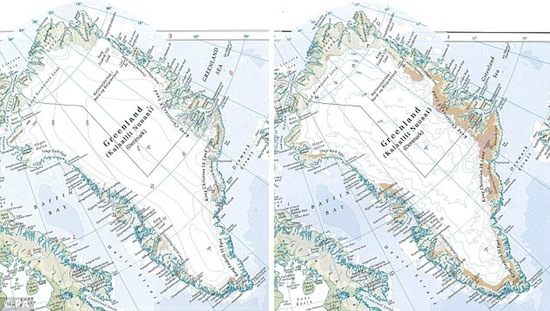Here's the good news: Greenland did not lose 15 percent of its ice cover in the last 10 years, as the Times [Usually] Comprehensive Atlas of the World said it did. This is, in fact, really good news, since this amount of melting would raise sea levels three to five feet. The publisher, HarperCollins subsidiary Collins Geo, has retracted the 15 percent figure but says it's "reviewing" the map — but in the meantime, a whole bunch of scientists went "whoa whoa whoa there."
Here's the bad news: Deniers eat this shit up. Remember the IPCC report that had an error about Himalayan glaciers? Remember how that error occurred in a section of the report that had nothing to do with establishing the scientific basis of climate change? Remember how deniers still pounced on that error as proving that the scientific basis of climate change was completely made up by some kind of secret cabal?
Poul Christofferson of the Scott Polar Research Institute remembers:
The substantial consequences of making inaccurate or exaggerated claims in the climate change debate came to light after the Intergovernmental Panel on Climate Change incorrectly stated in their last assessment report, that Himalayan glaciers could vanish before 2035. Although this mistake was not made within the actual assessment of the physical science basis of climate change, the unravelling of this mistake nonetheless lasted more than a year and was damaging not just to the IPCC, but the wider scientific community.
In the aftermath of what is often referred to as "Himalayagate," scientists are well aware that one big error can cloud a thousand truths. This is why the science community tackled the Times Atlas mistake swiftly and effectively.
This isn't a scientific error — the publishers misinterpreted data, although until they're done "reviewing" we might not know for sure how or why. One glaciologist guesses that the mapmakers confused ice thickness with ice cover extent, although Collins Geo says they didn't. At any rate, no scientist told them that Greenland had lost 15 percent of its ice. But it still runs the risk of being interpreted, and publicized, as a scientific confabulation.
Christofferson hopes that the fact that a whole bunch of scientists pointed out the error will keep this from turning into another Himalayagate or Climategate or some other -gate yet to come where an error in scientific (or in this case cartographic) judgment gets falsely presented as the nail in global warming's coffin.
Christofferson is careful to point out that, even if ice loss in Greenland is way WAY smaller than advertised, it's still a pretty major problem:
The current annual loss of ice from Greenland is about 200 cubic kilometers per year. This is about 0.007 percent of the total ice volume, but the same as 6 milimeters/decade in terms of sea level rise. This is a substantial number which excludes losses from other ice sheets and ice caps, and mountain glaciers, which tend to melt faster.
So we should worry about climate change and its impact, not only on the Greenland Ice Sheet, but ice masses across the world as a whole.
Hopefully he's right, and the Times Atlas error has been nipped in the bud early enough that people won't use it as an excuse to ignore very real concerns. We'll see. That may be expecting a lot.



